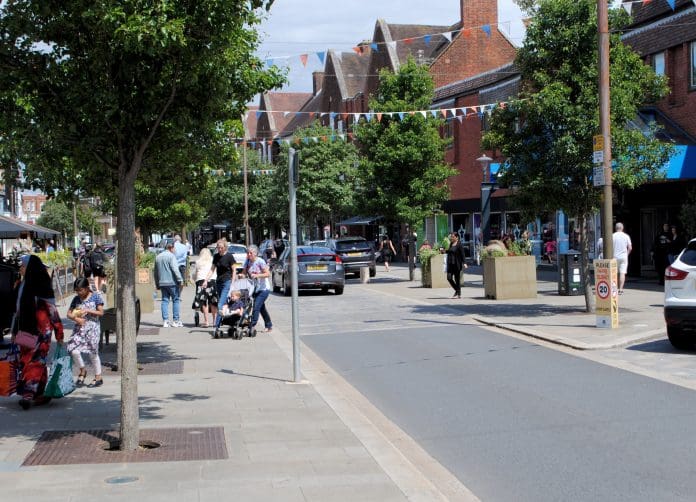David Edwards, architect, urban planner and designer, petty cyclist, car owner and someone who would definitely never leave children unattended to go on a city break, asks why the 15-minute city is encountering hostility in the UK at a time when the rest of Europe seems happy to embrace it
Earlier this year, I was invited by PBC Today to prepare a balanced review of the key components of the 15-minute city, which was a little surprising given my general ignorance and scepticism about the subject at the time.
I began with trepidation and concluded, finding it very difficult to disagree with the intent behind any of the guiding principles.
For me, the principles are very clear, but on reflection in the context of this article, this is perhaps because they have been written from an urban planning perspective. In this respect, UN-Habitat presents them well here:
“Say yes to walking, biking and public transit. Imagine neighbourhoods where everything you need is just 15 minutes away! Rediscover the joy of strolling to your favourite spots, chatting with neighbours and reducing your carbon footprint! Let’s bring back the charm of compact, interconnected communities!”
Many UK towns and cities are already examples of a 15-minute city
In reality, the majority of town and city dwellers in the UK are already living this way: I often walk to work, the nearest local centre is about 400m away, the town centre is a further 600m away, and when I need to go further, I can reach the train station in less than 15 minutes.
Additionally, we are generally an outdoorsy nation of walkers and cyclists, supporters of independent shops and local produce – and who doesn’t enjoy a short city break when you can leave the car (and ideally the children – supervised, obviously!) behind?
However, for some reason, the narrative around 15-minute cities/neighbourhoods/districts in the UK has completely shifted. Rather than representing one way to improve personal wellness and reduce global warming, it is portrayed as a car-demonising infringement of civil liberty.
This follow-up article considers why, when the rest of the world embraces the idea as a happy, healthy and sustainable way of living, it is being met with fear and negativity in the UK.
One of the main criticisms is that 15-minute neighbourhoods are a way to control, monitor and restrict our movements. This is inherently incorrect – it is actually based on encouraging mobility and interaction with our neighbours.
It is envisaged this misinterpretation has resulted from another criticism that walkable neighbourhoods are “anti-car”. Professor Moreno, the concept’s founder, has gone to some lengths to clarify the difference between these and why this is untrue.
Essentially, the objective is to reduce traffic congestion and improve air quality by promoting active travel where possible. In short, if the local shop is less than a mile away, we are likelier to walk or cycle there than to drive. In doing so, we might meet a neighbour and stop to chat, improving our mental health and sense of community.
15-minute cities v LTNs
As discussed in the earlier article, a reason for the anti-car label appears to come from some association with Low Traffic Neighbourhoods (LTN). However, these are not the same at all. LTNs are physical proposals for traffic calming in urban areas to create “home zones” or “living streets” – where residents can gather and children might play.
Conversely, 15-minute districts are a construct based on clustering enough local centre activities around homes so residents will have less need or inclination to drive.
It would also be incorrect to assert that LTNs are a way of creating 15-minute districts. Rather, the inverse is true, where it is first necessary to ensure sufficient local amenities before considering initiatives to reduce car dependency.
Essentially, unless we start building homes closer to facilities, facilities closer to homes or public transport links between homes and facilities, residents will continue to rely on private cars for transportation.
The well-publicised suggestion of a “socialist concept” that was made by a Conservative MP in February has presumably come from a misinterpretation of either of the guiding principles of “creating links between people” and “encouraging residents to shape their own environment”. The same aspirations underpin the NPPF, the Levelling-Up programme and the Shared Prosperity Fund.
European cities are moving away from cars in urban centres
At the same time as transport secretary Mark Harper was “calling time” on 15-minute cities at the Conservative Party Conference in October, Stockholm’s leaders were announcing that within the next 12 months, the city centre, an area that is home to one million people, would be free from petrol and diesel cars.
This is partially achievable through the city’s extensive public transport network, and northern Europe is already well ahead of the curve in supporting and facilitating active travel. But still, this is a major statement of intent from the capital of Europe’s tenth-biggest economy and the world’s seventh-happiest population.
Next door, the capital of the world’s second happiest population – Copenhagen – aims to ban combustible engines from its centre by 2030. While the centre of Amsterdam – the capital of the world’s fifth happiest people – is already largely car-free.
Is the UK falling behind?
Meanwhile, in the UK, plans to stop the sale of petrol and diesel cars by 2030 were recently deferred to 2035, the cross-country mass transit extension of HS2 has now been shelved altogether.
While our European neighbours are striving to create a more resilient and sustainable future, the UK government’s environmental agenda is regressing, and the transport secretary’s recent comments on the 15-minute concept only serve to illustrate this.
As a pure planning model, it represents an aspirational and inspirational vision for a way of living that most of us already enjoy, and I would urge any sceptics to first read the core principles before jumping to conclusions. At the end of the day, who could really find fault in the values of local services, active travel, community cohesion and local people shaping their own environments?
David Edwards
Principal
Placemake
Tel: +44 (0)1462 510 099

















